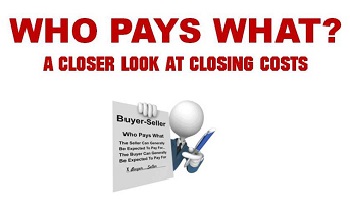Who Pays Closing Costs
 Listen, want a rush? Along about midnight, after your neighbors consume many adult beverages and are on the verge of speaking in tongues, see if they can tell you who pays closing costs. They may sweat a puddle trying to answer. If they know the answer, your buddies should chant, “Who pays closing costs? Closing costs are expenses over and above the price of the property in a real estate transaction.” Who pays closing costs? Mostly buyers because they are getting a loan to make the purchase, and many of the charges stem from the loan.
Listen, want a rush? Along about midnight, after your neighbors consume many adult beverages and are on the verge of speaking in tongues, see if they can tell you who pays closing costs. They may sweat a puddle trying to answer. If they know the answer, your buddies should chant, “Who pays closing costs? Closing costs are expenses over and above the price of the property in a real estate transaction.” Who pays closing costs? Mostly buyers because they are getting a loan to make the purchase, and many of the charges stem from the loan.
Within three days of applying for a home purchase loan, the lender must send you a loan estimate form which provides a detailed line-item breakdown of fees, cash needed to close, rate, terms, and costs over the life of the loan. This document spells out all the approximate costs the buyer will face when making the purchase, so there aren’t any surprising balloons at closing. You can use the information on the loan estimate form to shop for different lenders, interest rates, and costs.
Who Pays Closing Costs
Typically, buyers getting a loan will see some of the following costs:
|
|
Be sure to go through these fees line by line with your mortgage professional to understand exactly what they are and how they apply to your loan.
Aside from the expenses of getting a loan or buying a home, some expenses, such as property taxes or homeowners association dues, are pro-rated and paid at the time of closing. For example, if you’re buying a home and you close toward the end of the property tax period, you’ll likely need to pay the balance of taxes upfront.
The New Disclosures
We now have a consumer protection agency that protects us. It is called TRID. TRID requires consumers to receive two disclosures — one at the beginning of a transaction, and one at the end.
At least three days before closing, the lender must send you a Closing Disclosure Form, which looks almost exactly like the Loan Estimate but adds a breakdown of costs paid by the buyer versus seller versus third parties. This form means you’re reviewing final terms in the same format you saw initially, and you’ve got time to digest it.
Discount Points
“Many borrowers and prospective homeowners out there are looking for the lowest possible interest rate, even if it means pulling money out of their pocket at the time of financing.” They are looking at buying down the rate or buying mortgage points or paid points.
“Though most borrowers usually opt for a higher mortgage rate to avoid paying closing costs when buying a home or refinancing, some savvy homeowners will pay the one-time fees and take a lower interest rate to save money over the long term.
Of course, this strategy only really makes sense if you plan to stay with the mortgage for a long period.”
Sellers pay the commission
For sellers, there are always fewer line items on an estimated closing statement. But the seller generally bears the biggest brunt of the fees: the real estate commission.
A percentage of the total sale price goes to the real estate agent as a commission, so it tends to be the biggest fee. In addition to the real estate commission, sellers may have to pay the balance of their property taxes, if they haven’t done so already, as well as any prorated homeowners association dues.
Rather than read all about who pays closing costs again, I’d rather sit under the trees dressed in fall colors and watch the leaves fall. You may wonder why I would dress in fall colors and sit under the trees. And I would answer: so my grandkids would think I’m a pile of leaves and come running.
Terra Firma Property Solutions, LLC is a professional, full-service real estate solutions firm.
We buy and sell properties throughout the greater Kansas City area. We specialize in buying distressed homes, then renovating and reselling them to home buyers and landlords. Terra Firma Property Solutions: excited to be part of the economic rejuvenation of Kansas City and its surrounding areas.
Call us today at (816) 866.0566
